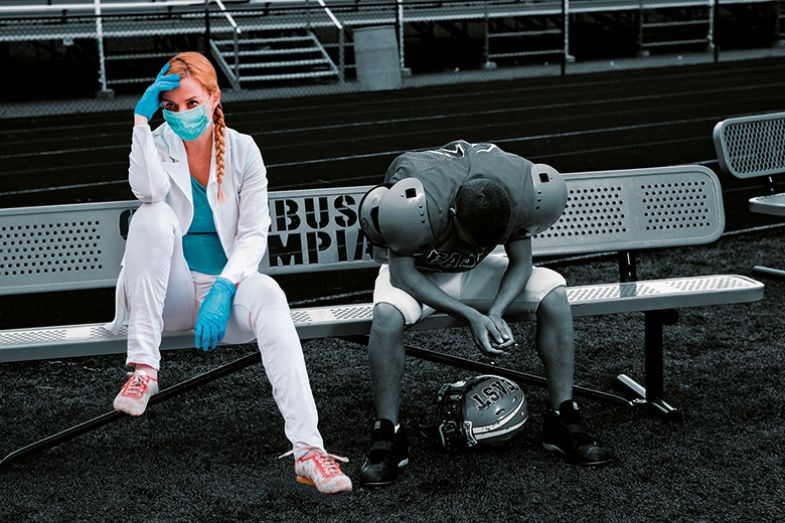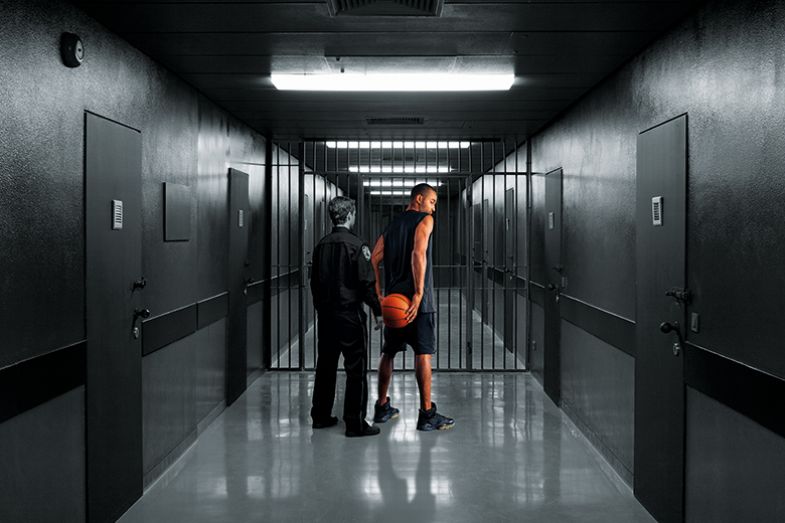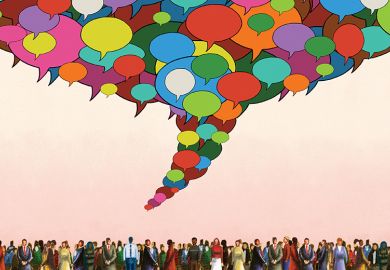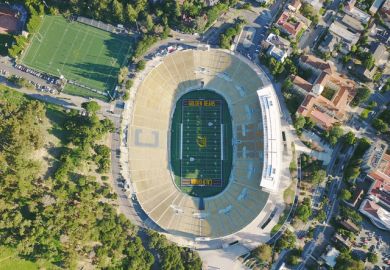It might seem strange to compare the lives and labour of American college athletes and science graduate students with those of prisoners. The last group is often treated brutally and can be forced to work (and indeed represents the sole exception to the US Constitution’s prohibition of slavery). College athletes and graduate students in labs, by contrast, are normally portrayed as enviable or even glamorous figures in popular culture.
But despite the obvious and important differences between the three groups, there are also significant similarities, particularly in how their labour is controlled. In the more than 80 interviews and other research that formed the basis for my new book, Coerced: Work under Threat of Punishment, I built on the long sociological tradition of what George Steinmetz, Charles Tilly collegiate professor of sociology at the University of Michigan, calls “odious comparisons”. Howard Becker explores the technique in his 2013 book What About Mozart? What About Murder?: Reasoning from Cases. Other scholars, such as Everett Hughes and Erving Goffman, have also compared radically different cases and identified often-surprising points of intersection between them in order to elucidate broader social phenomena. I describe here some of the things I have learned from my own “odious comparison”.
At the most basic level, prisoners, college athletes and science graduate students in the US have in common that they are neither culturally nor legally deemed “workers”. They do not have a right to the federal minimum wage and overtime pay, nor to unionise and bargain collectively. They do not have access to medical leave and workers’ compensation if they fall ill or get injured at work. They cannot receive unemployment benefits if they are laid off.
Yet they all perform labour that generates substantial financial returns. Prisoners prepare and serve food, mow lawns and shovel snow, all for very little or no pay, and so do the work that keeps prisons running. As a result, governments do not have to hire “regular” (full-pay and full-benefits) workers to do such labour. Meanwhile, in the academic sciences, PhD students (along with postdocs) conduct much – and sometimes all – of faculty research. While faculty members design and oversee projects in the lab, graduate students do much of the labour needed to carry them out. As a result, faculty in the sciences are bosses as well as teachers, and graduate students are in a labour as well as an educational relationship with them.
Like incarcerated labour, moreover, graduate student labour yields sizeable economic returns. Although widely described as “cheap”, graduate students are actually paid less than the market value of their labour. Their student stipends are often paid from the external grants their research helps to obtain, and such grants also subsidise faculty salaries and universities’ administrative costs. More broadly, graduate student labour helps universities cultivate their reputations as generators of scientific innovation, enabling them to recruit faculty and students, and to sustain the research-publication-grant cycle that undergirds science in the academy.
Meanwhile, top-level college athletes spend long hours labouring in sports arenas, a rigorous work schedule around which their education must be squeezed. In the case of American football and basketball players, in particular, such athletic labour can generate multimillion-dollar salaries for coaches and even more for universities, athletic conferences and/or the National Collegiate Athletic Association (NCAA). Private companies, as well, have profited handsomely from athletes’ labour by commodifying their names, photographs, likenesses, jersey numbers and equipment (although court rulings have begun to proscribe some of these practices).
Yet despite all such labour, both graduate students and college athletes have been legally deemed “primarily students” rather than workers – for example, in a 2015 ruling regarding Brown University. Although workers, activists and even judges have challenged (and continue to challenge) this ruling, both groups are still broadly considered trainees instead of employees: apprentices in the lab, amateurs on the field. As a result, they are paid in education and training rather than wages (although they often receive basic stipends).
As students, moreover, their earnings outside the lab and off the court can be capped. For graduate students, the general expectation is that they will not take on any other job, and this expectation can be formalised and enforced by granting agencies, universities, departments or faculty advisers. For Division I athletes, the NCAA explicitly places restrictions on the kinds of employment they can accept and how much they can earn. They are not allowed to profit from their athletic labour or “brand” by doing commercials or charging for autographs (although a recent California ruling may change that).

Many people have argued forcefully that graduate students, college athletes and prisoners should all be legally categorised as “employees”, but that is not my central focus here. Rather, by drawing on in-depth interviews with these strikingly different groups of workers, I want to explore how their status as non-workers shapes the power dynamics of their labour relations.
In each case, that status allows their supervisors unusually expansive punitive power over them. Prisoners can lose their eligibility for parole or even be put in solitary confinement, disrupting their ability to maintain basic human relationships with friends and families, while harming their physical and mental well-being.
For the student workers in my study, the punishments that their bosses can wield are obviously much less severe, although similarly expansive. As American football player “Bill Murdock” put it to me: “I felt like all my dreams were on the line every single day at practice. And I better do well, or else.” (In the case of all the people I quote here, I use the pseudonyms they requested.) Coaches are powerful gatekeepers, determining whether athletes can compete in any given game or season, which determines whether they can be recruited to play professionally. And, of course, coaches talk to professional recruiters, recommending athletes – or not. As elite basketball player “Lindsay” explained: “Your coach is going to be talking to the coaches of the WNBA [Women’s National Basketball Association],” and they are going to be asked, “‘What’s this kid like on your team? Like, does she get along with everybody? Is she a troublemaker? Does she cause problems? Or does she fall in line?’”
The primary risk, Lindsay and the other athletes told me, is that their coaches could characterise them as “un-coachable”. “That’s a big thing for coaches,” Lindsay explained. “‘Yeah, she’s un-coachable: she doesn’t really listen; she talks back.’”
But, for athletes, it is not just their athletic “dreams” that are on the line. Their education is as well. “The thing about [athletics] scholarships,” former American football player “M. Max” said, “is they can literally take your scholarship from you if they want to, if you’re not performing. That’s what a lot of people don’t know. You have to re-sign for your scholarship every year. It’s not like you sign on a dotted line and you get four years of college for free. You sign on a dotted line [and] you have to do everything they say or they can take your scholarship anytime they want.”
Although most of the athletes I interviewed believed that they would have to do something “really egregious” to lose their scholarships, they all had a profound sense of the power their coaches held over them: power over whether they could play their sport, whether they could be recruited professionally, and whether they could get a university education. As a result, they did everything they could to “fall in line”.
Graduate students’ lab bosses wield similar levers of power over them, since faculty advisers control their education, degree awards and future employment. While they can dismiss students from PhD programmes if they think they are performing badly, they can also prevent students from graduating precisely because they have become productive workers in the lab. As “Ron” (now a chemistry professor) put it, “I’ve absolutely heard tell of advisers who have essentially prevented their students from coming up for their PhD defence because, out of nowhere, they suddenly became productive, and [advisers] want to keep them on longer to get more production out of them.”
This was also common practice in the chemistry department where “Laine” got her PhD. “I haven’t talked to anybody where that’s not the case,” she said. “You’re trying to leave, you’re trying to set up your career, you’re going on job interviews, you’re writing your dissertation, you’re wrapping up your research, and all the while your professor is trying to squeeze every last experiment out of you.”
Faculty control not only PhD students’ research, but the products of such research, including publications, patents and inventions. (Indeed, faculty own these products because they own the labs in which they were produced.) They can therefore decide whether and how prominently to put a student’s name on a paper. In combination with letters of recommendation, this gives faculty advisers immense power over students’ professional success.
As chemistry professor “Henry” explained: “Without a doubt, the most profound way an adviser can wield power is in writing a letter of recommendation.” This was particularly a problem for “Kimberly May”, whose faculty adviser was also her harasser. “I can’t use him,” she said. “I can’t get a letter from him. I wouldn’t want to get a letter from him. So I would have to get a letter from someone else, which would be automatically flagged, like, ‘Wow, why is she not getting endorsed by her PhD adviser? There must be some problems there.’ And automatically I am assumed to be the problem.” In Kimberly May’s view, her only recourse was to leave the academy.
In most cases, however, graduate students sought to “fall in line”, to use basketball player Lindsay’s words, complying in every way possible in order to finish their degrees and find work in the field. As Laine explained, even though one of her faculty advisers was “mean”, “nasty” and “really bad”, she “would have never spoken out against him in a million years: never, no matter what he did, said – anything…If you don’t have clout, and if you’re not protected, if you don’t have that PhD…you’re just so vulnerable.”

Of course, not all faculty advisers, coaches or even corrections officers are mean and nasty, and not all of them deploy their punitive powers. But those who do are not “bad apples”. They are not exceptions to the rule. They are the rule. Their access to such expansive punitive power is simply the way it is in these labour relations and, as a result, often remains unquestioned by workers and supervisors alike.
If an athlete does not comply with her coach’s dictates, she will likely lose playing time and may even lose her scholarship. If a graduate student does not follow his adviser’s directives, he may very well lose the support that can lead to future employment opportunities. Thus graduate students and college athletes, like prisoners, not only labour in the absence of most employment protections and remedies, they labour under the threat of punishment. Whether or not they experience such punishment, this awareness pervades their working life, fundamentally shaping their actions and experiences.
All this suggests a number of possible responses. Even while their employment status remains unchanged, college athletes and graduate students could forge new labour coalitions. And there is certainly a case for something that no student workers currently have access to: the equivalent of an HR department. This would oversee coaches and faculty advisers in their roles as bosses, and offer recourse for students – without carrying the fear of retribution – when workplace problems arose.
Many people would no doubt want to go a lot further. My “odious comparison” illustrates just what is at stake.
Erin Hatton is an associate professor in the department of sociology at the University at Buffalo, New York. Her book Coerced: Work under Threat of Punishment was recently published by the University of California Press.
POSTSCRIPT:
Print headline: Workers, but not ‘working’
Register to continue
Why register?
- Registration is free and only takes a moment
- Once registered, you can read 3 articles a month
- Sign up for our newsletter
Subscribe
Or subscribe for unlimited access to:
- Unlimited access to news, views, insights & reviews
- Digital editions
- Digital access to THE’s university and college rankings analysis
Already registered or a current subscriber?








